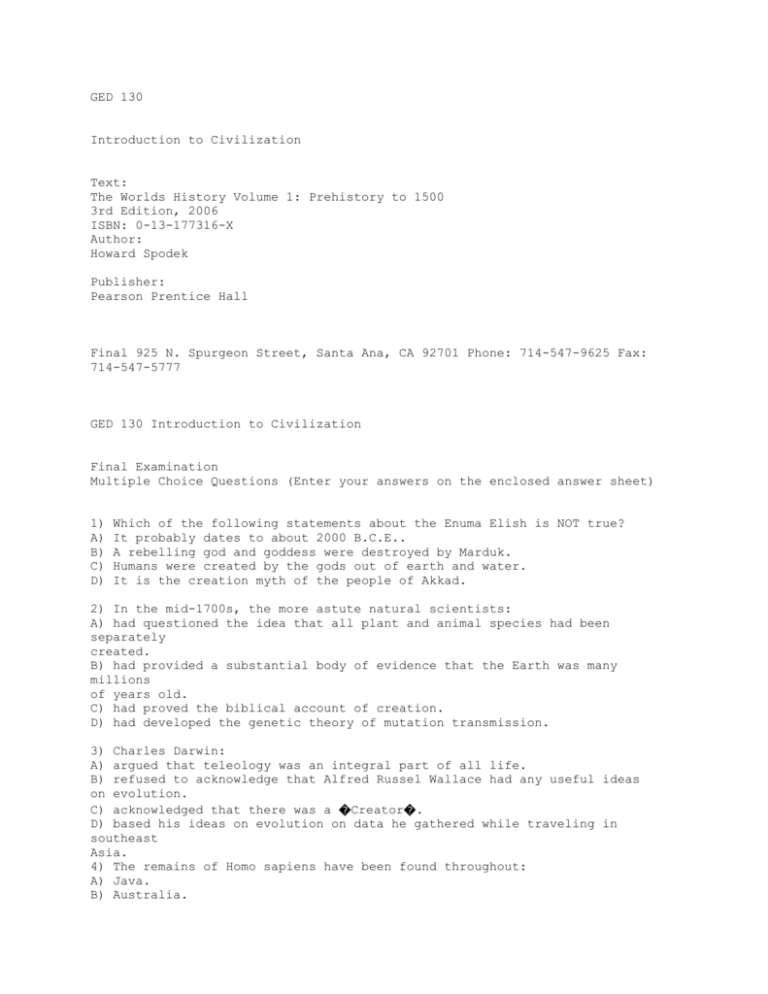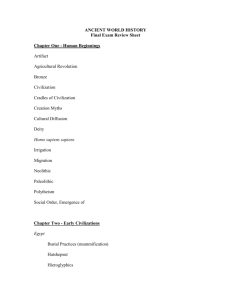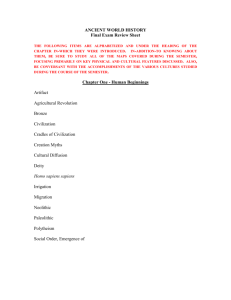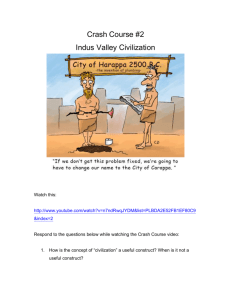
GED 130
Introduction to Civilization
Text:
The Worlds History Volume 1: Prehistory to 1500
3rd Edition, 2006
ISBN: 0-13-177316-X
Author:
Howard Spodek
Publisher:
Pearson Prentice Hall
Final 925 N. Spurgeon Street, Santa Ana, CA 92701 Phone: 714-547-9625 Fax:
714-547-5777
GED 130 Introduction to Civilization
Final Examination
Multiple Choice Questions (Enter your answers on the enclosed answer sheet)
1)
A)
B)
C)
D)
Which of the following statements about the Enuma Elish is NOT true?
It probably dates to about 2000 B.C.E..
A rebelling god and goddess were destroyed by Marduk.
Humans were created by the gods out of earth and water.
It is the creation myth of the people of Akkad.
2) In the mid-1700s, the more astute natural scientists:
A) had questioned the idea that all plant and animal species had been
separately
created.
B) had provided a substantial body of evidence that the Earth was many
millions
of years old.
C) had proved the biblical account of creation.
D) had developed the genetic theory of mutation transmission.
3) Charles Darwin:
A) argued that teleology was an integral part of all life.
B) refused to acknowledge that Alfred Russel Wallace had any useful ideas
on evolution.
C) acknowledged that there was a �Creator�.
D) based his ideas on evolution on data he gathered while traveling in
southeast
Asia.
4) The remains of Homo sapiens have been found throughout:
A) Java.
B) Australia.
C) Eurasia.
D) Africa.
5) Homo first used fire about:
A) 5 million years ago.
B) 200,000 years ago.
C)30,000 years ago.
D) 1 million years ago.
6)
A)
B)
C)
D)
Homo sapiens:
was a tool user.
had the smallest brain capacity of any hominid yet discovered.
were first discovered in fossils in the late seventeenth century.
means �man with developed brain�.
GED 130 Introduciton to Civilization
Final Examination
7)
Most archaeologists and paleoanthropologists believe:
A)
B)
C)
D)
Homo
Homo
Homo
Homo
erectus
erectus
erectus
erectus
evolved into Homo
first appeared in
first appeared in
evolved into Homo
sapiens only on the African continent.
Africa.
western Europe.
sapiens in several regions.
8)
Which of the following events in evolutionary history happened fi rst?
A) first birds
B) first amphibians
C) first dinosaurs
D) first reptiles
9)
Which of the following is NOT a reason put forth in the text for the
disappearance of Neanderthals?
A)
B)
C)
D)
Neanderthals
Homo sapiens
Homo sapiens
Neanderthals
interbred with Homo sapiens sapiens.
sapiens destroyed the Neanderthals through violence.
sapiens out-competed Neanderthals for resources.
warred with each other and drove themselves to extinction.
10) Linguist Noam Chomsky argues that the ability to use language is:
A) genetic.
B) learned from the environment.
C) learned from parents.
D) a gift of the gods.
11)
The �Venus� figurine pictured in the text:
A)
B)
C)
D)
was made between 5,000 and 7,000 years ago.
is probably a fertility charm.
indicates that the people of that era were on a near-starvation diet.
was found in southern Africa.
12) Which of the following stages of human development happened fi rst?
A)
B)
C)
D)
rapid brain growth
human migrations to America
development of speech
domestication of animals
GED 130 Introduction to Civilization
Final Examination
13) The first animals to be domesticated in the �Fertile Crescent� were:
A)
B)
C)
D)
goats and sheep.
dogs.
llamas and turkeys.
pigs and cattle.
14) Which of the following empires was organized fi rst?
A) Persian
B) Assyrian
C) Neo-Babylonian
D) Hittite
15) The Bronze Age:
A)
B)
C)
D)
occurred before there were written records.
was a time of significant technological breakthroughs.
preceded the Paleolithic Age.
was a time when little of relevance occurred.
16) The world�s first system of writing evolved in:
A) southeast Asia.
B) the Indus Valley.
C) Khmer.
D) Sumer.
17) The Sumerians were finally conquered by:
A) Nefertiti of Egypt.
B) Sargon of Akkad.
C) Alexander the Great of Macedon.
D) Hammurabi of Babylon.
18) Although the Sumerians did not speak Semitic, their use of Semitic names
suggests:
A)
B)
C)
D)
they had been ruled at one time by a Semitic-speaking people.
Semitic-speaking people may have preceded them in the area.
their language had evolved from Semitic.
that they had migrated from a Semitic speaking region.
19) Which of the following is NOT a Sumerian city-state?
A) Akkad
B) Kish
C) Uruk
D) Lagash
GED 130 Introduciton to Civilization
Final Examination
20) The city-states of Mesopotamia were especially vulnerable due to:
A) inter-urban warfare.
B) their lack of organized armies.
C) inability to grow enough food to adequately feed their populations.
D) powerful external enemies.
21) In Sumerian times, the idea of legal identity and loyalty was based most
fundamentally on:
A) clan.
B) religion.
C) class.
D) geography.
22) Of the following, which has given us the best idea of important Sumerian
values?
A)
B)
C)
D)
royal correspondence
lamentations
king lists
epics
23) This people invented writing:
A) Babylonians
B) Akkadians
C) Sumerians
D) Egyptians
24) Scholars know the least about this civilization:
A)
B)
C)
D)
Nile valley
Greek city-states
Indus valley
Tigris-Euphrates valley
25) Egyptians wrote on paper made from:
A) linen.
B) papyrus pith.
C) cotton.
D) limestone fl akes.
GED 130 Introduction to Civilization
Final Examination
26) The earliest known writing samples were concerned primarily with:
A)
B)
C)
D)
the activities of royalty.
commerce.
law codes.
religious practices.
27) In ancient Egypt:
A)
B)
C)
D)
most pyramids were located near the fi fth cataract.
Nubia was to the south.
the Red Sea was to the north.
Upper Egypt was to the north.
28) Horus:
A)
B)
C)
D)
was the father of Osiris.
represented the southern portion of Egypt.
ruled the underworld.
became the main god of the pharaohs.
29) Akhetaten:
A)
B)
C)
D)
was the site of worship of the sun god Aten.
was built by the pharaoh Ramses II.
was used as a capital for nearly 800 years.
is considered the best representative of the typical Egyptian city of its
day.
30) The art and craftwork of the Indus Valley indicates:
A)
B)
C)
D)
they
that
they
they
were a nomadic people.
the civilization was not very well developed.
did not possess metallurgical skills.
participated in active interregional trade.
31) The settlements of Harrapa and Mohenjo-Daro could each accommodate:
A)
B)
C)
D)
about
about
about
about
10,000 residents.
40,000 residents.
2,500 residents.
25,000 residents.
GED 130 Introduciton to Civilization
Final Examination
32) Which of the following is NOT one of the four legacies of Harappa
described in the text?
A) Aryan invaders nearly completely destroyed the Indus valley civilization.
B) Aryan invaders adopted some of the Indus valley agricultural techniques.
C) Aryan invaders adopted some of the settlement characteristics of the Indus
valley civilization.
D) Aryan invaders may have adopted some religious ideas of the Indus valley
civilization.
33) The Indus valley civilization:
A)
B)
C)
D)
made little use of agricultural practices.
built numerous temples and palaces.
began around 7000 B.C.E.
reached its apex around 1000 B.C.E.
34) Neolithic groups in China began the transition from hunting and gathering
to farming and village life as early as:
A)
B)
C)
D)
1700
8000
9000
2700
B.C.E.
B.C.E.
B.C.E.
B.C.E.
35) Chinese oracle bones:
A) were usually made from human bones.
B) first came to the attention of scientists after they were found at
excavation
sites.
C) have been useful to archaeologists, anthropologists, and historians for at
least three centuries.
D) have provided useful information about the rulers of the Shang dynasty.
36) The Xia dynasty:
A) was ruled by a single king who controlled all the powers of the state.
B) did not leave any significant archaeological sites, so little is known
about it.
C) had rulers that engaged in rituals and divinations.
D) apparently did not make pottery.
GED 130 Introduction to Civilization
Final Examination
37) Anyang:
A) is one of the most extensively investigated archaeological sites in China.
B) was the last capital of the Zhou dynasty.
C) was the center of a small empire about 30 miles in diameter.
D) was mentioned in Shang texts, though it was referred to by a different
name.
38) Early urbanization in South America:
A)
B)
C)
D)
was spurred by the high volume of trade with Mesoamerica.
followed a much different path than that typical in Mesoamerica.
was not significant until about 500 C.E.
centered on religious shrines.
39) The Inca empire:
A)
B)
C)
D)
forbade any use of the religion or culture of its predecessor states.
practiced monotheism.
lasted for nearly 1000 years.
built an extensive network of roads and paths.
40) The Popol Vuh contains the creation myth of the:
A)
B)
C)
D)
Roman Catholic conquistadores from Spain.
the Aztec civilization.
the Inca civilization.
the Mayan civilization.
41) Which of the following Central American civilizations was the first to
develop sophisticated astronomy?
A) Mayan
B) Olmec
C) Teotihu
D) Aztec
42) Of the following African cities, which one is NOT believed to have
followed a development pattern introduced from other cultures?
A) Kush
B) Aksum
C) Jenne-Jeno
D) Malindi
GED 130 Introduciton to Civilization
Final Examination
43) Jenne-Jeno:
A) was founded around 250 B.C.E.
B) was a settlement on the Yellow River.
C) did not appear to engage in trade.
D) was first excavated in the early twentieth century.
44) Imperial dominance:
A) requires the use of sheer power to enforce rule.
B) is another term for imperial hegemony.
C) has little effect on the likelihood of revolt by subjugated peoples.
D) exists when rulers make no attempt to gain the allegiance of conquered
peoples.
45) The Hittite empire was centered:
A) on the upper Nile.
B) in Anatolia.
C) in Palestine.
D) in Mesopotamia.
46) Which of the following was at different times controlled by the Hittites
and by the Mitanni?
A) Harran
B) Tarsus
C) Babylon
D) Nineveh
47) The Greek city-state:
A) typically had populations exceeding 100,000.
B) was kept small by wars with the Persian empire.
C) usually centered on a single city.
D) had political powers analogous to that of a state within the United
States.
48) The Persian Empire:
A) reached its greatest geographical extent under Cyrus the Great.
B) easily conquered the Scythians.
C) failed to defeat Greece at the battle of Marathon.
D) maintained itself through a balance of power among the major Middle East
states.
GED 130 Introduction to Civilization
Final Examination
49) Which of the following events occurred first?
A)
B)
C)
D)
the
the
the
the
Battle of Marathon
2nd Peloponnesian War
construction of the Acropolis
burning of Persepolis
50) Alexander the Great:
A)
B)
C)
D)
never managed to conquer Egypt.
saw his empire slowly disintegrate during the last years of his life.
forced conquered peoples to worship Greek gods and goddesses.
typically ruled through local hierarchies.
51) Which of the following explains why Alexander failed to carry his empire
as far as the Ganges in India?
A)
B)
C)
D)
He lacked the financial resources to accomplish the task.
His troops mutinied.
The Persian forces overwhelmed his troops.
He died before he could reach India.
52) Which of the following empires began as city-states?
A) Egyptian and Persian
B) Mesopotamian and Egyptian
C) Macedonian and Greek
D) Mesopotamian and Greek
53) The city of Rome was founded in approximately:
A)
B)
C)
D)
753
241
509
405
B.C.E.
B.C.E.
B.C.E.
B.C.E.
54) Carthage:
A) was eventually defeated by Rome, but was given an honored place within
the empire.
B) had little military success when Hannibal invaded Italy.
C) lost all three Punic Wars.
D) lay nearly 800 miles away from Italy.
GED 130 Introduciton to Civilization
Final Examination
55) The Roman patron-client relationship:
A) defined a state of reciprocity between the weak and the strong.
B) applied primarily to the business sector.
C) allowed for an approximate equality between people of different classes.
D) led to the end of the role of the paterfamilias.
56) The triumvirate formed in 60 B.C.E. did NOT include this man:
A) Crassus
B) Pompey
C) Tiberius
D) Julius Caesar
57) Rome�s armies:
A)
B)
C)
D)
required few male citizens to actually serve in it.
were often made up in part by men from conquered regions.
were paid for primarily by taxes on Roman citizens.
spent little time developing new technology.
58) The belief system of Rome:
A) prohibited paganism.
B) did not allow any holidays.
C) incorporated Christianity within a few decades of the death of Jesus.
D) centered on the emperor as a god.
59) The Silk Road linked which of the following cities?
A)
B)
C)
D)
Sarapion and Asabon
Luoyang and Bactra
Antioch and Alexandria
Luoyang and Guangzhou
60) The fall of the Roman Empire:
A) did not occur, according to most historians, until the Byzantine Empire
was destroyed in 1453.
B) was due primarily to the disrupting influence of Christianity.
C) occurred despite solid leadership over the final 200 years.
D) was hastened by the actions of Germanic peoples.
GED 130 Introduction to Civilization
Final Examination
61) Confucius:
A)
B)
C)
D)
felt that some people were born evil and could not be changed.
was made a high ranking advisor to a Chinese leader.
lived during the period of the Warring States.
had little lasting impact on the conduct of government in China.
62) Daoism:
A)
B)
C)
D)
was developed primarily to guide statesmen.
is quite similar to Confucianism.
presents a detailed set of formal rules to guide society.
stresses a closeness to the natural world.
63) The Mandate of Heaven:
A)
B)
C)
D)
could allow a dynasty to rule forever.
was a personal god worshipped by emperors.
showed it was pleased by creating natural disasters.
blessed moral rulers.
64) Over the course of the Han dynasty, this group rose to the top of the
social and political hierarchy:
A) generals
B) priests
C) scholars
D) merchants
65) Regarding economic policy of the Han empire, it is true that:
A) Confucians opposed military expansion in part because it was so costly.
B) the empire had to make do with what it had when it was founded, since
no new sources of wealth were discovered.
C) Emperor Wu cut taxes.
D) Han emperors refused to nationalize private enterprise.
66) The Tang dynasty:
A)
B)
C)
D)
made major changes in the policies of the previous dynasty.
abandoned the imperial examination system.
presided during a major flowering of Chinese poetry.
persecuted Buddhism.
GED 130 Introduciton to Civilization
Final Examination
67) Japan:
A) modeled its art on that of the southeast Asian islands.
B) accepted the cultural hegemony of China.
C) was careful to keep its borders closed to immigrants during its early
years.
D) was conquered twice by China.
68) The Aryan peoples in India:
A)
B)
C)
D)
spoke a Semitic language.
first arrived in the Indus valley in 1000 B.C.E.
were expelled from the region by the Maurya dynasty.
formed political groupings called janapadas.
69) Which of the following was written first?
A)
B)
C)
D)
the Bhagavad-Gita
the Mahabharata and Ramayana
the Puranas
Sangam poetry
70) The Kushana:
A)
B)
C)
D)
were supporters of Buddhism.
invaded India just prior to the rule of the Mauryan family.
left no artifacts traceable to the time of their rule.
came from the Iranian plateau.
71) India�s �adivasis�:
A) usually live in the less-accessible areas
B) have rarely been able to assert any independence.
C) farm some of India�s richest soil.
D) are well described in ancient historical records.
72) Funan:
A)
B)
C)
D)
controlled only a small area around the mouth of the Mekong River.
encouraged Hinduism.
built Angkor Wat.
did not allow the influence of Buddhism into its territory.
GED 130 Introduction to Civilization
Final Examination
73) Asoka�s empire:
A) was not described in known historical records until a find about 100 years
ago.
B) was overthrown by barbarian invasions from the north.
C) expelled many Hindus.
D) included the island of Sri Lanka.
74) The oldest religion still in practice is:
A) Hinduism.
B) Christianity.
C) Judaism.
D) Buddhism.
75) The caste system in India:
A) is officially sanctioned by the Rigveda.
B) has no relevance in the India of today.
C) does not provide for a soldier class.
D) officially provides for six castes.
76) The Puranas focus least on this:
A)
B)
C)
D)
stories of gods
stories of goddesses
the deep philosophical concepts of Hinduism
folk tales
77) Mahayana Buddhism:
A)
B)
C)
D)
never presented a serious challenge to Theravada Buddhism.
believed in the bodhisattva concept.
took its name from the Sanskrit term for �lesser vehicle�.
argued there was no heaven.
78) Hinduism and Buddhism were similar in all of the following aspects,
except:
A)
B)
C)
D)
the degree of respect they gave to brahmins.
their development of sacred languages.
their belief in reincarnation.
their place of origin.
GED 130 Introduciton to Civilization
Final Examination
79)
The Buddhist center furthest from the site of Buddha�s enlightenment is
located in:
A) Kandy
B) Bamiyan.
C) Kotabangun.
D) Edo.
80) Jesus� most important commandment was to:
A)
B)
C)
D)
honor your father and mother.
love your neighbor.
give to the poor.
love God.
81) Paul:
A)
B)
C)
D)
opposed slavery in both principle and practice.
sought to subordinate women in the church.
was Jesus� most devoted disciple in the years prior to Jesus� death.
felt that married clergy were closer to God than single clergy.
82) Which of the following Jewish groups stayed aloof from politics and
preached that the end of the world was imminent?
A) Essenes
B) Sadducees
C) Pharisees
D) Zealots
83) Monasteries:
A)
B)
C)
D)
were, after the Council of Nicea, exclusively for men.
were often located in urban areas.
tended to be complex political organizations.
usually contained members who were celibate.
84) In the eighth century, the advance of Islam into Europe was:
A)
B)
C)
D)
most rapid in Scandinavia.
most rapid in Italy.
stopped in southern France by Charles Martel.
of little consequence for the Catholic Church.
GED 130 Introduction to Civilization
Final Examination
85) Which of the following areas was NOT a major area of strength for Roman
Catholicism in the year 1200?
A) France
B) Kievan Russia
C) Germany
D) Italy
86) Muslims begin their calendar with this event:
A)
B)
C)
D)
the
the
the
the
birth of Muhammad.
birth of Abraham.
death of Muhammad.
date Muhammad moved to Medina.
87) Abu Bakr:
A)
B)
C)
D)
ruled for nearly 30 years.
was a direct descendent of Muhammad.
was the fi rst caliph.
refused to use force to keep recent converts faithful to Islam.
88) The campaigns of Genghis Khan extended as far west as:
A)
B)
C)
D)
the Caucasus Mountains.
Kaifeng.
Ain Jalut.
Liegnitz.
89) Ibn Khaldun held all of the following views, except:
A) the only differences between Westerners and Easterners are cultural, not
innate.
B) tensions between peoples is often related to class.
C) nomadic peoples tended to conquer urban peoples.
D) scholars are often the wisest rulers.
90) Use of the decimal system and the zero was first developed by the:
A) Indians.
B) Greeks.
C) Arabs.
D) Turks.
GED 130 Introduciton to Civilization
Final Examination
91) Before 1500 C.E., the greatest part of the exchange economy consisted of:
A) international trade.
B) local transactions.
C) long-distance transactions.
D) medium-distance transactions.
92) West African trade:
A)
B)
C)
D)
was conducted primarily by sailing ship.
was centered in Great Zimbabwe.
was dependent upon the camel to deliver goods to Europe.
is extensively documented for the period from about 200 C.E. to about
700 C.E.
93) After the ninth century, Arabs provided the main trading link between
East Africa and:
A) West Africa.
B) the Indian Ocean.
C) the Europe.
D) the Americas.
94) The primary focus of Polynesian sailors was:
A)
B)
C)
D)
to
to
to
to
establish an empire in the Pacifi c.
establish a trade system throughout the Pacifi c.
locate new places in which to settle.
explore the Pacifi c Ocean.
95) The bubonic plague:
A) was spread primarily due to the activities of the Mongols.
B) never reached China.
C) had less effect in Europe than in other places where the disease struck.
D) is transmitted by fl ies.
96) The Annales school of history:
A) was named for a Parisian cafaccent(e) frequented by French historians:
the Cafaccent(e) des Annales.
B) published a journal edited by historians for historians.
C) was centered in the University of Paris.
D) emphasized an interdisciplinary approach to history.
GED 130 Introduction to Civilization
Final Examination
97) In the high Middle Ages, most European Jews:
A)
B)
C)
D)
lived freely among Christians.
sought to return to ancient Israel and Judea.
were forbidden to loan money.
were often successful traders.
98) Prince Henry the Navigator established a center for the study of
navigation in order to:
A)
B)
C)
D)
control the eastern coast of Africa.
chart the oceans.
end Muslim control of the southern shores of the Mediterranean.
discover new lands.
99) Which of the following explorers was the first to clearly recognize that
Columbus had NOT discovered a route to Asia?
A)
B)
C)
D)
Vasco Nutilde(n)ez de Balboa
Vasco de Gama
Amerigo Vespucci
Bartolomeo Dias
100) The sea voyages of exploration and discovery:
A) were spearheaded by the prosperous
B) began with Columbus� discovery of
C) included the first round-the-world
first half of the sixteenth century.
D) were financed in large part by the
GED 130 Introduciton to Civilization
Final Examination
Italian city-states.
America.
voyage by Ferdinand Magellan in the
Ottoman Empire.







